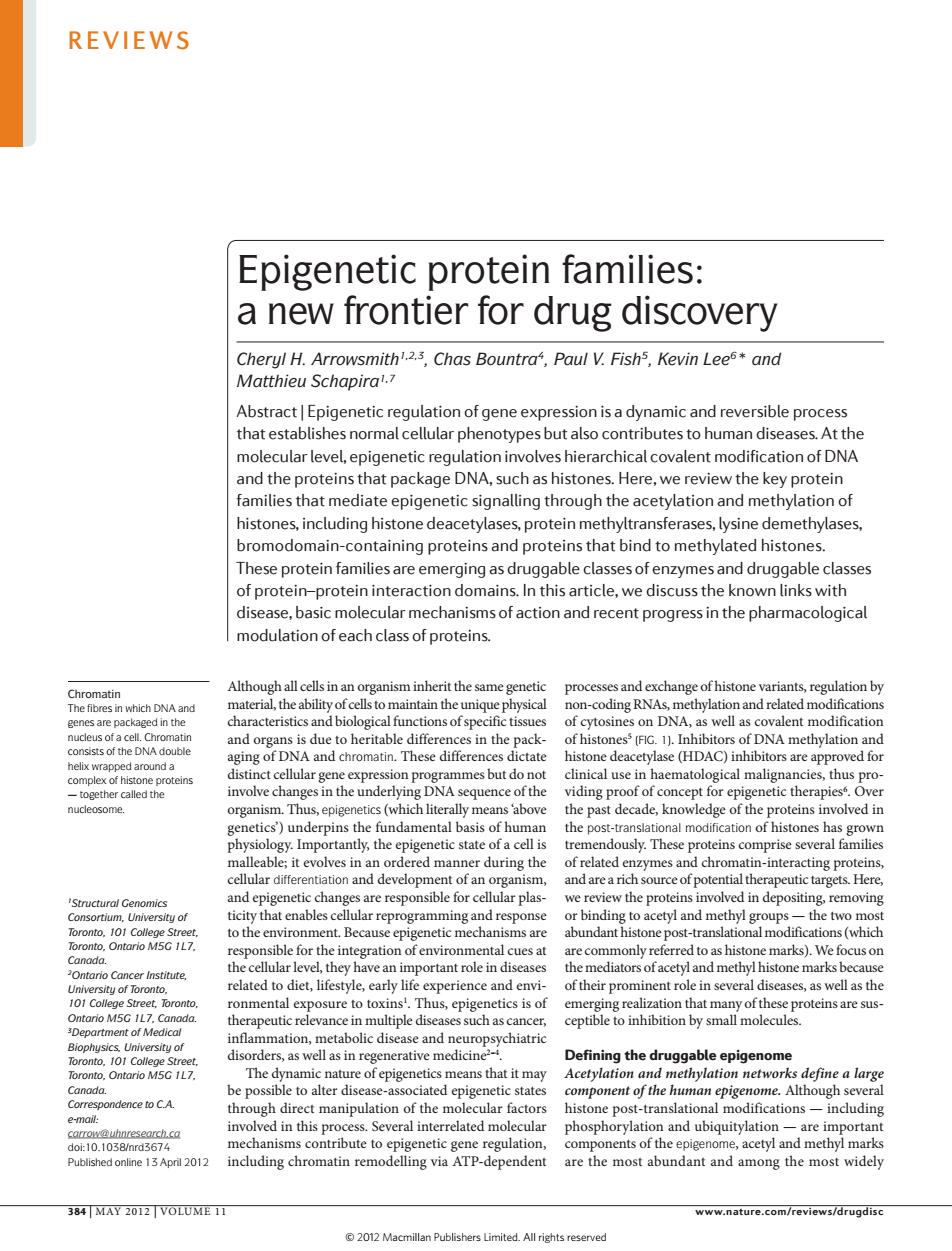正在加载图片...

REVIEWS Epigenetic protein families: a new frontier for drug discovery Cheryl H.Arrowsmith,Chas Bountra,Paul V.Fish,Kevin Leesand Matthieu Schapira'. Abstract Epigenetic regulation of gene expression is a dynamic and reversible process that establishes normal cellular phenotypes but also contributes to human diseases.At the molecular level,epigenetic regulation involves hierarchical covalent modification of DNA and the proteins that package DNA,such as histones.Here,we review the key protein families that mediate epigenetic signalling through the acetylation and methylation of histones,including histone deacetylases,protein methyltransferases,lysine demethylases bromodomain-containing proteins and proteins that bind to methylated histones. These p otein families。 protein protein intera domains.n thisarticle, ase,basic mo ar mechanisms of action and modulation of each class of proteins. material,the ability ctions of spec on DNA l.Chr aemato the past decade dge of the】 erpins the hun the post er during the of related s and chro opr arean lular rer ons s ar ne post hey have an in mportant roe in diseas elated t ce a of their prominent ro peuti relevan multiple c Defining the druggable epigenome The ym nature of epigen s that it may Acetylation nd cular factor histone post-translational nvol ed in this proc s.Several interrelated mo phosphorylation and ubiquitylationare importan including chromatin remodelling via ATP-dependent are the most abundant and among the most widely 384 MAY 2012 VOLUME 11 www.nature.com/reviews/drugdisc 2012 Macmillan Publishers Limited.All riehts reserved Although all cells in an organism inherit the same genetic material, the ability of cells to maintain the unique physical characteristics and biological functions of specific tissues and organs is due to heritable differences in the packaging of DNA and chromatin. These differences dictate distinct cellular gene expression programmes but do not involve changes in the underlying DNA sequence of the organism. Thus, epigenetics (which literally means ‘above genetics’) underpins the fundamental basis of human physiology. Importantly, the epigenetic state of a cell is malleable; it evolves in an ordered manner during the cellular differentiation and development of an organism, and epigenetic changes are responsible for cellular plasticity that enables cellular reprogramming and response to the environment. Because epigenetic mechanisms are responsible for the integration of environmental cues at the cellular level, they have an important role in diseases related to diet, lifestyle, early life experience and environmental exposure to toxins1 . Thus, epigenetics is of therapeutic relevance in multiple diseases such as cancer, inflammation, metabolic disease and neuropsychiatric disorders, as well as in regenerative medicine2–4. The dynamic nature of epigenetics means that it may be possible to alter disease-associated epigenetic states through direct manipulation of the molecular factors involved in this process. Several interrelated molecular mechanisms contribute to epigenetic gene regulation, including chromatin remodelling via ATP-dependent processes and exchange of histone variants, regulation by non-coding RNAs, methylation and related modifications of cytosines on DNA, as well as covalent modification of histones5 (FIG. 1). Inhibitors of DNA methylation and histone deacetylase (HDAC) inhibitors are approved for clinical use in haematological malignancies, thus providing proof of concept for epigenetic therapies6 . Over the past decade, knowledge of the proteins involved in the post-translational modification of histones has grown tremendously. These proteins comprise several families of related enzymes and chromatin-interacting proteins, and are a rich source of potential therapeutic targets. Here, we review the proteins involved in depositing, removing or binding to acetyl and methyl groups — the two most abundant histone post-translational modifications (which are commonly referred to as histone marks). We focus on the mediators of acetyl and methyl histone marks because of their prominent role in several diseases, as well as the emerging realization that many of these proteins are susceptible to inhibition by small molecules. Defining the druggable epigenome Acetylation and methylation networks define a large component of the human epigenome. Although several histone post-translational modifications — including phosphorylation and ubiquitylation — are important components of the epigenome, acetyl and methyl marks are the most abundant and among the most widely 1Structural Genomics Consortium, University of Toronto, 101 College Street, Toronto, Ontario M5G 1L7, Canada. 2Ontario Cancer Institute, University of Toronto, 101 College Street, Toronto, Ontario M5G 1L7, Canada. 3Department of Medical Biophysics, University of Toronto, 101 College Street, Toronto, Ontario M5G 1L7, Canada. Correspondence to C.A. e-mail: carrow@uhnresearch.ca doi:10.1038/nrd3674 Published online 13 April 2012 Epigenetic protein families: a new frontier for drug discovery Cheryl H. Arrowsmith1,2,3, Chas Bountra4, Paul V. Fish5, Kevin Lee6* and Matthieu Schapira1,7 Abstract | Epigenetic regulation of gene expression is a dynamic and reversible process that establishes normal cellular phenotypes but also contributes to human diseases. At the molecular level, epigenetic regulation involves hierarchical covalent modification of DNA and the proteins that package DNA, such as histones. Here, we review the key protein families that mediate epigenetic signalling through the acetylation and methylation of histones, including histone deacetylases, protein methyltransferases, lysine demethylases, bromodomain-containing proteins and proteins that bind to methylated histones. These protein families are emerging as druggable classes of enzymes and druggable classes of protein–protein interaction domains. In this article, we discuss the known links with disease, basic molecular mechanisms of action and recent progress in the pharmacological modulation of each class of proteins. Chromatin The fibres in which DNA and genes are packaged in the nucleus of a cell. Chromatin consists of the DNA double helix wrapped around a complex of histone proteins — together called the nucleosome. REVIEWS 384 | MAY 2012 | VOLUME 11 www.nature.com/reviews/drugdisc © 2012 Macmillan Publishers Limited. All rights reserved